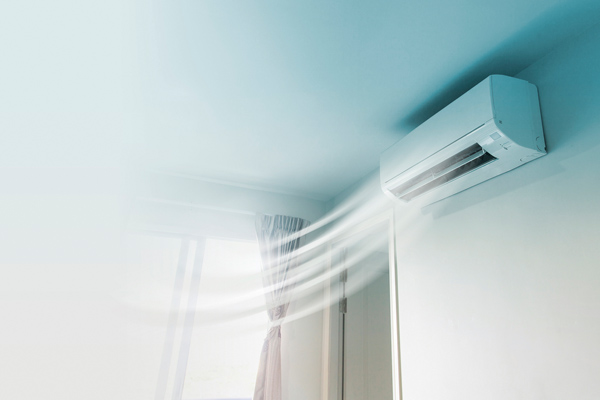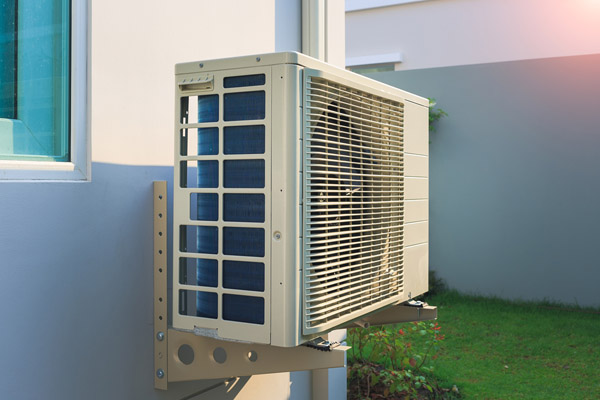How Do Ductless Air Conditioners Work?

Unlike central air conditioners, ductless air conditioners, as their name suggests, have no ducts. Similar to central ACs, ductless ACs cool a given space by sucking in warm air, absorbing moisture and heat from that air, and then dumping the moisture/heat outside. Because they lack ducts, ductless ACs deliver cold air right into a targeted space/room. On the other hand, central ACs channel cold air into a system of air ducts that then distribute it throughout a home. However, many homeowners still question, “How Do Ductless Air Conditioners Work?”.
How Do Ductless Air Conditioners Work?
Contents
Here’s some more information on this topic.
Components Of A Ductless AC Unit

Ductless air conditioners consist of three main components including:
- An evaporator/blower unit – An evaporator/blower unit is the part of the ductless air conditioner that sits indoors, in the room that the AC serves. These components are typically thin and about 3′ long. Their function is to pull in the warm air in the room. Absorb moisture and heat from the air and then channel the cold air back to the room. These units direct cold air into the room while also simultaneously sending the moisture and heat outside through the ‘conduit.’
- A conduit – A conduit connects the indoor component of the AC with the outside component. Basically, the conduit is a thin and long cable that comprises the refrigerant tubing, condensation drain, and power cable. The conduit provides electrical power to the indoor and outdoor parts of the ductless AC. It’s also the corridor through which moisture and heat from the inside of your house are channeled on their way to the exit point, the condenser.
- A condenser – The condenser is the ‘outside’ component of the ductless AC. Its function is to take all the heat emanating from your house and ‘unload’ it outside.
Single-Zone Mini-Split Vs Multi-Zone Ductless Setups
Is ductless AC effective in multi-room applications? Well, ductless AC units are effective in both single rooms and multi-zone spaces. You can install ductless AC systems in various settings based on these two platforms:
- Single-Zone Mini-Split: A mini-split comprises of single evaporator/blower unit and an outdoor condenser. This makes it ideal for cooling a single room. If you have enough outdoor space to set up multiple condensers, you can set up numerous ductless ACs that work simultaneously to cool an entire building. This kind of system provides customizable temperature control in each zone. Furthermore, if one system malfunctions, the rest won’t be affected.
- Multi-Zone Ductless HVAC: There are two variants of multi-split ductless AC systems. The first relies on a single outdoor condenser that’s connected to multiple indoor evaporator/blower units. In this configuration, each one of the indoor units is coupled with a thermostat. When there is a need for cooling, all units are set off concurrently. This configuration is much more cost-effective. It’s ideal for buildings where all rooms have different cooling loads.
If you want a customizable system that allows for true zoning, you can opt for a multi-zone mini-split system that comes with detached compressor circuits that are linked with each evaporator/blower unit. This enables the occupants of each zone to customize temperature control settings based on their needs.
Do Ductless Air Conditioners Have Adequate Cooling Power?
While individual indoor units look small, they’re meant to cool a single zone/room which makes cooling easier. However, for your unit to serve you effectively, you need to match BTU capacity with the size of the room. Generally, the bigger the size of the room, the higher the BTU rating you’ll need. It is best to determine your cooling load with the help of an HVAC contractor. They will use various factors to determine what is best for you.
A system that’s too small for a given space will overwork to cool the space, leading to rapid wear and tear and frequent HVAC repairs. Conversely, if you install a system that is too large, it will short cycle, which means it will turn on and off frequently and this can shorten its life span. Here are the common sizes:
- Rooms measuring between 400 and 650 square feet will need a unit that provides 12,000 BTUs per hour.
- For rooms measuring between 600 and 1000 square feet, you need a unit that provides 18,000 BTUs per hour.
- Larger rooms measuring between 800 and 13,000 square feet will need a unit that provides 24,000 BTUs per hour.
Call a licensed HVAC contractor to learn more about ductless air conditioning systems.
Pros And Cons Of Ductless Air Conditioners

Below, we discuss some of the pros and cons of ductless cooling systems:
Pros Of Ductless AC
- Ductless air conditioners come with in-built zoning. The systems enable the occupants of each room to customize temperature control settings.
- Ductless ACs are energy efficient. Duct leakage leads to the wastage of 20 to 30 percent of conditioned air, According to Energy.gov. With ductless cooling systems, you don’t have to worry about duct leaks.
- Ductless AC units are an ideal and less costly cooling system for homes with no preinstalled ductwork. Many older homes don’t have the space needed for the installation of additional or new ductwork. Besides, installing ductwork often involves cutting through walls, floors, and ceilings, making it a lengthy and costly endeavor.
- Ductless ACs are versatile, they can be mounted on the floor, walls, ceilings, depending on the configuration of your home.
Cons Of Ductless Cooling Systems
- While ductless AC typically cost more upfront, they are generally more customizable and more energy efficient. Take note that the cost of the associated ductwork can significantly increase the upfront cost of a central AC system, making the system more expensive than a similar-sized ductless system.
- Unlike central ACs that can be hidden in the basement, attic, or closet, ductless ACs are typically mounted on walls, the floor, or the ceiling, meaning they’re difficult to hide. However, they are typically less obtrusive and sleeker compared to window AC units.
Conclusion
Ductless Air Conditioners are customizable, versatile, and energy-efficient. Besides, they eliminate the need for an air distribution duct, which means they are generally cheaper to install and maintain compared to central air conditioners.
Call McAllister Energy To Learn More About Ductless HVAC Systems

McAllister Energy provides the best cooling and heating services in the area. Our team consists of experienced certified technicians who can assist you with first-rate HVAC installations, repairs, tune-ups, and replacements. All of our technicians have years of experience and advanced knowledge to provide proper HVAC service.
McAllister Energy offers very competitive rates for cooling and heating services in the area. We can recommend the best HVAC replacement systems for you while staying within your budget. Our top priorities are comfort, indoor air quality, and energy efficiency, to name a few. Get in touch with McAllister Energy today for your free in-house estimate or to schedule an appointment.
You can click here to contact us now or call us at (856) 665-4545 to find out more!